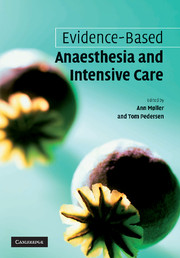Book contents
- Frontmatter
- Contents
- Foreword
- Contributors
- 1 Introducing evidence-based anaesthesia
- 2 How to define the questions
- 3 Developing a search strategy, locating studies and electronic databases
- 4 Retrieving the data
- 5 Critical appraisal and presentation of study details
- 6 Outcomes
- 7 The meta-analysis of a systematic review
- 8 Bias in systematic reviews: considerations when updating your knowledge
- 9 The Cochrane Collaboration and the Cochrane Anaesthesia Review Group
- 10 Integrating clinical practice and evidence: how to learn and teach evidence-based medicine
- 11 Involving patients and consumers in health care and decision-making processes: nothing about us without us
- 12 Evidence-based medicine in the Third World
- 13 Preoperative anaesthesia evaluation
- 14 Regional anaesthesia versus general anaesthesia
- 15 Fluid therapy
- 16 Antiemetics
- 17 Anaesthesia for day-case surgery
- 18 Obstetrical anaesthesia
- 19 Anaesthesia for major abdominal and urological surgery
- 20 Anaesthesia for paediatric surgery
- 21 Anaesthesia for eye, ENT and dental surgery
- 22 Anaesthesia for neurosurgery
- 23 Cardiothoracic anaesthesia and critical care
- 24 Postoperative pain therapy
- 25 Critical care medicine
- 26 Emergency medicine: cardiac arrest management, severe burns, near-drowning and multiple trauma
- Glossary of terms
- Index
3 - Developing a search strategy, locating studies and electronic databases
Published online by Cambridge University Press: 05 September 2009
- Frontmatter
- Contents
- Foreword
- Contributors
- 1 Introducing evidence-based anaesthesia
- 2 How to define the questions
- 3 Developing a search strategy, locating studies and electronic databases
- 4 Retrieving the data
- 5 Critical appraisal and presentation of study details
- 6 Outcomes
- 7 The meta-analysis of a systematic review
- 8 Bias in systematic reviews: considerations when updating your knowledge
- 9 The Cochrane Collaboration and the Cochrane Anaesthesia Review Group
- 10 Integrating clinical practice and evidence: how to learn and teach evidence-based medicine
- 11 Involving patients and consumers in health care and decision-making processes: nothing about us without us
- 12 Evidence-based medicine in the Third World
- 13 Preoperative anaesthesia evaluation
- 14 Regional anaesthesia versus general anaesthesia
- 15 Fluid therapy
- 16 Antiemetics
- 17 Anaesthesia for day-case surgery
- 18 Obstetrical anaesthesia
- 19 Anaesthesia for major abdominal and urological surgery
- 20 Anaesthesia for paediatric surgery
- 21 Anaesthesia for eye, ENT and dental surgery
- 22 Anaesthesia for neurosurgery
- 23 Cardiothoracic anaesthesia and critical care
- 24 Postoperative pain therapy
- 25 Critical care medicine
- 26 Emergency medicine: cardiac arrest management, severe burns, near-drowning and multiple trauma
- Glossary of terms
- Index
Summary
This chapter shows how to conduct a comprehensive, objective and reproducible search for studies. It can be the most time-consuming and challenging task in preparing a clinical question for a project or a systematic review. Yet it is also one of the most important. Identifying all relevant studies, and documenting the search for studies with sufficient detail so that it can be reproduced, is after all, largely what distinguishes a systematic review from a traditional narrative review in evidence-based medicine. This chapter explains how, and where, the reviewers should look for studies that may be eligible for inclusion in The Cochrane Library, MEDLINE, EMBASE and other relevant databases that identify appropriate MeSH terms (Medical Subjects Headings). Although currently it is necessary to search multiple sources to identify relevant published studies, it is envisioned that the Cochrane Central Register of Controlled Trials (CENTRAL) in The Cochrane Library will become a comprehensive source for published studies, thus reducing the searching burden for authors. Identifying ongoing studies, however, will continue to remain a challenge until a comprehensive, searchable, ongoing trial register is produced to track, organise, and disseminate reports for ongoing studies, as CENTRAL in The Cochrane Library does for reports of studies that have been published.
- Type
- Chapter
- Information
- Evidence-based Anaesthesia and Intensive Care , pp. 7 - 18Publisher: Cambridge University PressPrint publication year: 2006



